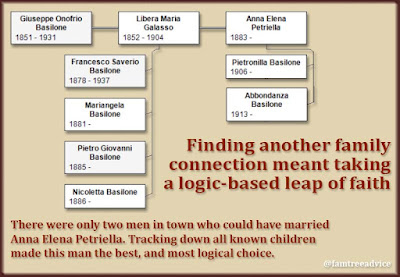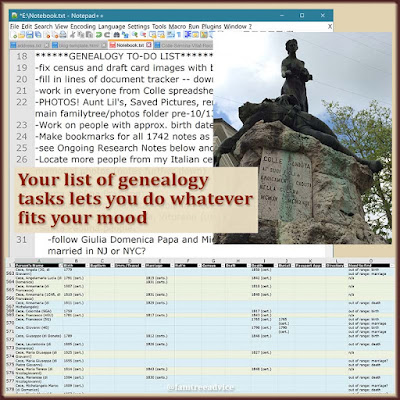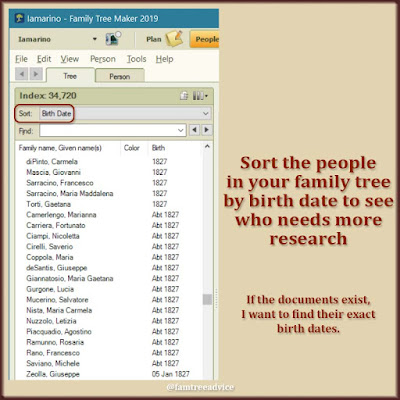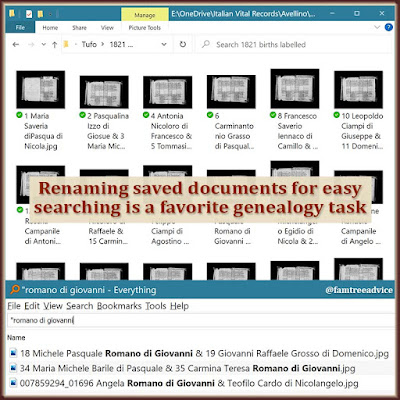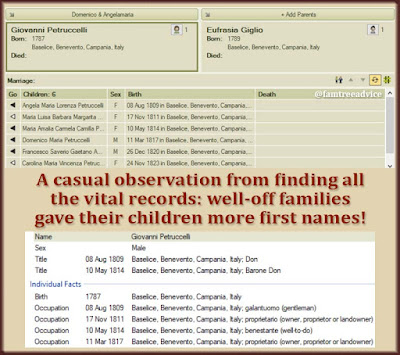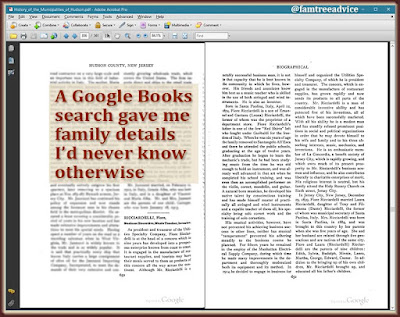Twenty years ago I knew absolutely nothing about my great grandmother in Ohio. I met her only once when I was five years old.
When I was about to leave for my 2003 honeymoon in Italy, my aunt mentioned my great grandmother's last name. Caruso. I never knew what her last name was before that moment.
After visiting Italy, I wanted to know more and more about my ancestors. Great grandma Caruso was one of my biggest mysteries. Relatives couldn't agree on her first name. A cousin who grew up with great grandma Caruso remembered her saying she was from "Pisqua Lamazza." Well, that isn't a town. But it was a clue.
 |
| Maria Rosa was barely a memory for me. Now I have so much great information! |
Here are all the puzzle pieces that had to come together for me to trace great grandma Caruso's past. Once I cracked her mystery, I was able to climb five generations up her family tree.
Immigration Record
I had to figure out what town she came from that sounded like "Pisqua Lamazza." I tried a simple trick that I've used over and over again. I searched Ancestry for anyone named Caruso coming to New York Harbor in the early 1900s. In the search results, I paid attention only to each person's hometown.
And then I saw it. Pescolamazza. That was it! I could imagine someone with a heavy accent pronouncing that town the way great grandma Caruso did. Now that I had the name of her hometown, I went to Google Maps. But Pescolamazza doesn't exist. A separate Google search had the answer. The town of Pescolamazza had changed its name to Pesco Sannita in 1947.
To my delight, Pesco Sannita is very close to my ancestral hometown of Colle Sannita. And all my other ancestral hometowns.
Knowing the town name, I found a 1906 ship manifest showing the arrival of Maria Rosa Caruso in America. The only problem was, it said she was married.
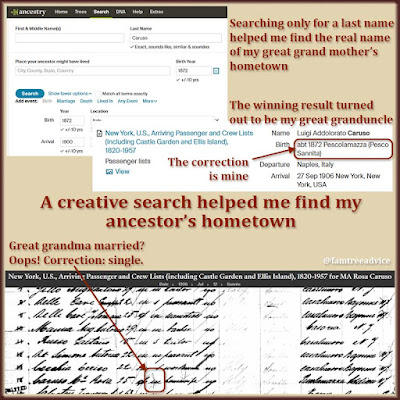 |
| For years I wasn't sure this was my great grandmother on the ship manifest. Then I saw the truth was hiding in plain sight. |
Town Hall Record
Based on her age written on the July 1906 ship manifest, Maria Rosa Caruso was born in 1881 in today's Pesco Sannita. An Italian friend offered to go to the town hall to request Maria Rosa's 1881 birth record for me.
The town clerk said Maria Rosa wasn't born there. He suggested she might be from a neighboring town. How disappointing!
Marriage Record
In 2009 I visited the New York State Archives. I found out my great grandparents married on 29 November 1906 in Steuben County. I had the certificate number, so I sent away for the document.
I realized that Maria Rosa married my great grandfather four months after arriving in America. Four months!
Her marriage certificate managed to get both of her parents' names wrong. They listed Maria Rosa Caruso's father as Francesco deBenevento. This was obviously a misunderstanding. He was Francesco Caruso from the province of Benevento. For her mother, it said only Maria Luigia. No last name.
But now I had a document saying she was 26 years old in late 1906. So she wasn't born in 1881. She was born in 1880. The Pesco Sannita town clerk would have checked the index of the book of 1881 births. He didn't look beyond the year we requested.
 |
| They're great to have, but your immigrant ancestor's new-world documents often have bad information. |
Another Cousin
It's so important to put your family tree online. Another cousin found me and shared a lot of information about the Caruso family. He'd been to Pesco Sannita a few times. Too bad he didn't find me sooner.
Thanks to him, I learned the names of all the Caruso brothers. They were working for the railroad before sending for their only sister. They must have worked with my great grandfather and arranged for him to marry their sister. That's why my great grandparents married so quickly.
I still wondered if the 1906 ship manifest was the right one. It said she was already married. When I took a closer look at it, I could see a very light "S" written right over the "m" for married. A few lines above her, someone had lightly written "single" over the "m" for married. Now, at last, I knew I'd really found her.
Vital Records
I'd spent a few years viewing microfilmed Italian records at a Family History Center. I was concentrating on another branch of the family. It would take many more years before I'd get around to Pesco Sannita.
That all changed in 2017. I learned the Italian government was putting digitized vital records online for free. The Antenati website gave me access to tons of records from Pesco Sannita.
My first stop was the 1880 birth records. Not only did I find Maria Rosa's birth record—with her parents' full and proper names—I discovered she was a twin! Sadly, the second-born twin, Luca, was stillborn.
To this day, I'm continuing to explore the Pesco Sannita vital records to grow Maria Rosa's family. The early drip, drip, drip of clues about my great grandmother is now a full-on stream of facts.
All kinds of obstacles may keep you from climbing to that next generation in your family tree. Solving the mystery of a single ancestor can take:
- a bunch of different documents
- some imagination, and
- access to just the right records.
Gather every shred of evidence you can, and if that isn't enough, gather more!



